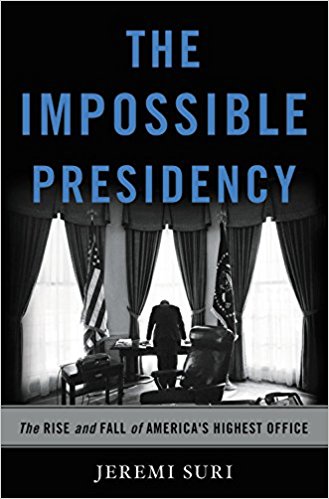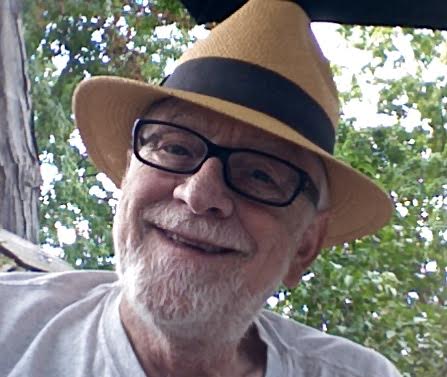By Robert R. Thomas
In 2008 American mythology got a sobering lesson delivered by profligate banksters who caused a near-collapse of the global economy. They then explained to the political class the economic alt-reality of BIG. How big? Too big to fail. Even bigger than our government and the rule of law. No banksters went to jail. Instead we taxpayers bailed them out. Too big to get it right was rewarded. So much for the rule of law in an alt-reality of too big to fail.
 In this age where lies are gospel and alt-realities supersede the empirical truths of reality world, Jeremi Suri’s The Impossible Presidency delivers a sobering critique of another American myth, the invincible office and expansive power of the presidency.
In this age where lies are gospel and alt-realities supersede the empirical truths of reality world, Jeremi Suri’s The Impossible Presidency delivers a sobering critique of another American myth, the invincible office and expansive power of the presidency.
Suri’s analysis, documented by 30 pages of notes and references, is aptly sub-titled “The RISE and FALL of AMERICA’S HIGHEST OFFICE.” The book is organized in two parts: RISE and FALL. Titled “Alone,” the first chapter begins with the author’s major premise:
“The presidency is the most powerful office in the world, but it is set up to fail. And the power is the problem. Beginning as a small and uncertain position within a large and sprawling democracy, the presidency has grown over two centuries into a towering central command for global decisions about war, economy, and justice. The president can bomb more places, spend more money, and influence more people than any other figure in history. HIs reach is almost boundless.”
But as Suri points out, “reach does not promote desired results.” The reason: the job has gotten too big and too powerful for any one person to manage effectively. The job has gotten too big to succeed. Hence the RISE and the FALL segments of his book.
Breathtaking scope and demands
Of the many examples the book offers portraying a job that has gotten way too big for one person’s britches, are the calendar examples from a day in the life of Franklin Roosevelt, John Kennedy, and Lyndon Johnson. Those daily entries illustrate the expanding scope of the power and demands of the office through those presidencies. Johnson’s schedule for March 11, 1965 is six pages long and breathtaking in its scope and demands.
By the time Kennedy and Johnson came along, the demands of constant crises, national and international, challenging the presidency were exacerbated by managing a gigantic federal government bureaucracy.
“Power defined Kennedy and Johnson,” writes Suri, “more than they defined it. They departed from their priorities because they felt they had to….Kennedy and Johnson were unable to rise above their crises and congested calendars.”
The Reagan era ushered in a different approach
With Reagan, the first professional actor mounted the stage of the presidency.
“Reagan freed the presidency from sinking in excessive day-to-day responsibilities, focusing executive leadership on a few simple, deeply-held, and widely shared aspirations,” writes Suri. “He returned the presidency to mission over management. That was the source of his early success, but also the trap for his later shortcomings, which required major policy adjustments.”
There were two Reagan presidencies, according to Suri, the one that began with promise and the one that ended in scandal. While Reagan remained personally popular, perceptions of the American presidency as an office reached a new low, which the author points out was even lower than after Lyndon Johnson’s and Richard Nixon’s terms in office. “Citizens no longer trusted the president or believed he could solve big problems,” he writes. “Presidential rhetoric was anti-government, but the late twentieth-century presidency was a creature of big government. That trend has only continued, to the dismay of Reagan’s successors.”
In come the “brilliant generalists”
The book’s final chapter, “Magicians of Possibility,” examines the Clinton and Obama presidencies from their commoner roots to the most complex, demanding job in the world.
“From a young age, Clinton and Obama were brilliant generalists who could do nearly everything well (with seeming ease), but never chose to be the best at any single thing,” writes Suri. “They were confident and capable, not necessarily disciplined or devoted….Their idealism, evident early in each man, drove their actions.”
But their climb to the presidency needed help along the way. “Clinton and Obama used their talents to build bridges of various kinds that supported their ambitions, Suri writes. “That was the secret of their success from their earliest years to their remarkable White House ascendency. They had so few advantages, but so much talent, and an uncommon touch with diverse groups….Throughout their lives, Clinton and Obama cultivated a colorful mix of supporters.”
Suri uses the lens of novelist Toni Morrison, who identified Clinton as “our first black president.” Morrison’s distinguishing characteristic is common to both men beyond their ambitions and talents and authenticity, a quality lacking in all other candidates. “That something,” she writes, “is a creative imagination which coupled with brilliance equals wisdom.” She further noted that wisdom is not something one can train for or learn in school or earn at work. “Wisdom is a gift.”
American expectations stalk even the best
But despite the immense talents of these two magicians of possibility, the circumstances surrounding the office were bigger than one man in the White House, no matter how gifted. An examination of the modest gains and the failures of both Clinton and Obama are duly listed. As are formidable foes like the expectations of the American voters of one man in an impossible job and the Republican obstructionism that stalked each man, an obstructionism, according to Suri, “that was about policy, power, and identity.” The rapidly shifting scenes globally demand regular and immediate attention by the president. A copy of Clinton’s daily calendar for March 16, 1993 demonstrates that the demands of one man’s day were increasing exponentially, both in time and complexity.
Suri demonstrates that the power of the president expanded as presidents sought ways around logjams like nihilistic congressional obstructionism and legal convolutions. The major divide in the country deepened as disillusionment with the government and the presidency turned toward cynicism with the entire political structure.
The Impossible Presidency concludes:
“The presidency was too big, and ultimately too demanding, even for these (Clinton and Obama) unusually able and precocious men. Perhaps no one could master the modern presidency.
“Millions of voters understood that, on some level. They chose a brash personality who rejected the entire history of the office, to blow it all up. Trump was the president as destroyer. He banished the slick, swarthy magicians who had promised to do the impossible for an eager American (and global) audience. When the most talented figures failed, the ‘real man’ took over. Many voters obviously did not see an alternative. The impossible presidency produced a truly impossible president.”
Ultimately, the people make the presidency
The author’s plea for a new beginning in the book’s Epilogue addresses the problem of “too big to get it right” by suggesting we address making the office of the presidency less impossible. “The obvious lesson,” he writes, “is that the office needs new boundaries.” For Suri, an impossible president is not the solution. He quotes Abraham Lincoln reminding Americans in another time of crisis that we “hold the power and bear the responsibility.” As Suri puts it, “The people still make the presidency, and they can make it less impossible.”

Robert Thomas
Robert R. Thomas is an occasional reviewer for East Village Magazine and one of its board members. A resident of the Central Park neighborhood, he is a former priest and San Francisco cable car driver. He can be reached at capnz13prod@gmail.com.


You must be logged in to post a comment.